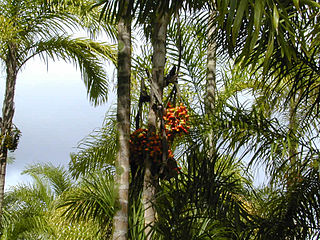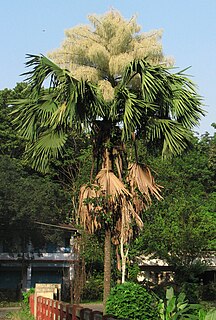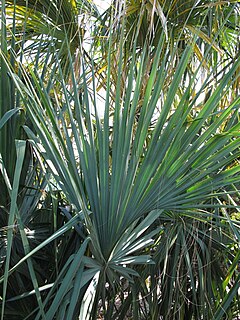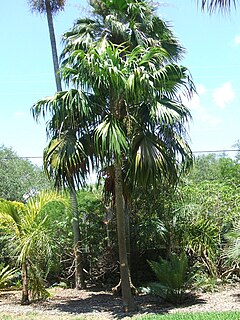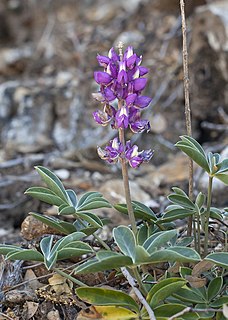| Metroxylon paulcoxii | |
|---|---|
| Scientific classification | |
| Kingdom: | Plantae |
| Clade: | Angiosperms |
| Clade: | Monocots |
| Clade: | Commelinids |
| Order: | Arecales |
| Family: | Arecaceae |
| Genus: | Metroxylon |
| Species: | M. paulcoxii |
| Binomial name | |
| Metroxylon paulcoxii McClatchey | |
Metroxylon paulcoxii is a species of palm endemic to Samoa. It is reported there from the islands of 'Upolu and Savai'i. The species is named in honor of ethnobotanist Paul Alan Cox. [2] [3]
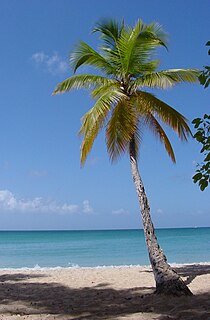
The Arecaceae are a botanical family of perennial plants. Their growth form can be climbers, shrubs, trees and stemless plants, all commonly known as palms. Those having a tree form are colloquially called palm trees. They are flowering plants, a family in the monocot order Arecales. Currently 181 genera with around 2600 species are known, most of them restricted to tropical and subtropical climates. Most palms are distinguished by their large, compound, evergreen leaves, known as fronds, arranged at the top of an unbranched stem. However, palms exhibit an enormous diversity in physical characteristics and inhabit nearly every type of habitat within their range, from rainforests to deserts.

Endemism is the ecological state of a species being unique to a defined geographic location, such as an island, nation, country or other defined zone, or habitat type; organisms that are indigenous to a place are not endemic to it if they are also found elsewhere. The extreme opposite of endemism is cosmopolitan distribution. An alternative term for a species that is endemic is precinctive, which applies to species that are restricted to a defined geographical area.

Samoa, officially the Independent State ofSamoa and, until 4 July 1997, known as Western Samoa, is a country consisting of two main islands, Savai'i and Upolu, and four smaller islands. The capital city is Apia. The Lapita people discovered and settled the Samoan Islands around 3,500 years ago. They developed a unique Samoan language and Samoan cultural identity.
Metroxylon paulcoxii can attain a height of 10 metres (33 ft), with a non-branching trunk up to 45 centimetres (18 in) in diameter. Leaves are pinnately compound, with spines on the sheaths, petioles, and leaf margins. Leaflets can number as many as 150, each up to 8 centimetres (3.1 in) wide and 100 centimetres (39 in) long. Inflorescences have second-order branching, with as many as 450 flowers per branch. Flowers are 5–10 millimetres (0.20–0.39 in) wide, with staminate (male), pistillate (female), and hermaphroditic flowers frequently present on the same plant. Fruits are pear-shaped, fibrous and corky, up to 7 centimetres (2.8 in) long. Seeds are spherical, up to 3.7 centimetres (1.5 in) in diameter. [2] [4] [5]
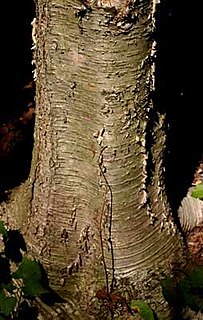
In botany, the trunk is the stem and main wooden axis of a tree, which is an important feature in tree identification, and which often differs markedly from the bottom of the trunk to the top, depending on the species. The trunk is the most important part of the tree for timber production.

Pinnation is the arrangement of feather-like or multi-divided features arising from both sides of a common axis. Pinnation occurs in biological morphology, in crystals, such as some forms of ice or metal crystals, and in patterns of erosion or stream beds.

An inflorescence is a group or cluster of flowers arranged on a stem that is composed of a main branch or a complicated arrangement of branches. Morphologically, it is the modified part of the shoot of seed plants where flowers are formed. The modifications can involve the length and the nature of the internodes and the phyllotaxis, as well as variations in the proportions, compressions, swellings, adnations, connations and reduction of main and secondary axes. Inflorescence can also be defined as the reproductive portion of a plant that bears a cluster of flowers in a specific pattern.
The species is similar to M. warburgii (also present in Samoa), but with shorter leaflets and with second-order branching in the inflorescence instead of third-order. [2]
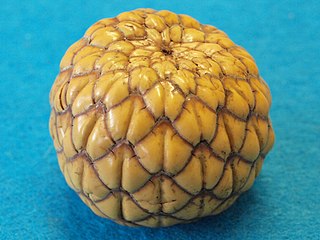
Metroxylon warburgii commonly called the natangura palm, is a species of flowering plant in the family Arecaceae. The specific epithet is in honor of Otto Warburg. The common name is from the Bislama name natanggura.

